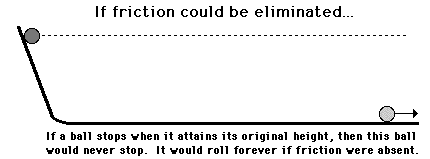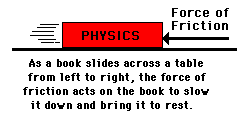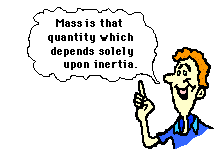Newton's conception of inertia stood in direct opposition to more popular conceptions about motion. The dominant thought prior to Newton's day was that it was the natural tendency of objects to come to a rest position. Moving objects, so it was believed, would eventually stop moving; a force was necessary to keep an object moving. But if left to itself, a moving object would eventually come to rest and an object at rest would stay at rest; thus, the idea that dominated people's thinking for nearly 2000 years prior to Newton was that it was the natural tendency of all objects to assume a rest position.Inertia: the resistance an object has to a change in its state of motion.
Galileo and the Concept of Inertia
Galileo, a premier scientist in the seventeenth century, developed the concept of inertia. Galileo reasoned that moving objects eventually stop because of a force called friction. In experiments using a pair of inclined planes facing each other, Galileo observed that a ball would roll down one plane and up the opposite plane to approximately the same height. If smoother planes were used, the ball would roll up the opposite plane even closer to the original height. Galileo reasoned that any difference between initial and final heights was due to the presence of friction. Galileo postulated that if friction could be entirely eliminated, then the ball would reach exactly the same height.Galileo further observed that regardless of the angle at which the planes were oriented, the final height was almost always equal to the initial height. If the slope of the opposite incline were reduced, then the ball would roll a further distance in order to reach that original height.


Forces Don't Keep Objects Moving
 Isaac Newton built on Galileo's thoughts about motion. Newton's first law of motion declares that a force is not needed to keep an object in motion. Slide a book across a table and watch it slide to a rest position. The book in motion on the table top does not come to a rest position because of the absence of a force; rather it is the presence of a force - that force being the force of friction - that brings the book to a rest position. In the absence of a force of friction, the book would continue in motion with the same speed and direction - forever! (Or at least to the end of the table top.) A force is not required to keep a moving book in motion. In actuality, it is a force that brings the book to rest.
Isaac Newton built on Galileo's thoughts about motion. Newton's first law of motion declares that a force is not needed to keep an object in motion. Slide a book across a table and watch it slide to a rest position. The book in motion on the table top does not come to a rest position because of the absence of a force; rather it is the presence of a force - that force being the force of friction - that brings the book to a rest position. In the absence of a force of friction, the book would continue in motion with the same speed and direction - forever! (Or at least to the end of the table top.) A force is not required to keep a moving book in motion. In actuality, it is a force that brings the book to rest.
Mass as a Measure of the Amount of Inertia
 All objects resist changes in their state of motion. All objects have this tendency - they have inertia. But do some objects have more of a tendency to resist changes than others? Absolutely yes! The tendency of an object to resist changes in its state of motion varies with mass. Mass is that quantity that is solely dependent upon the inertia of an object. The more inertia that an object has, the more mass that it has. A more massive object has a greater tendency to resist changes in its state of motion.
All objects resist changes in their state of motion. All objects have this tendency - they have inertia. But do some objects have more of a tendency to resist changes than others? Absolutely yes! The tendency of an object to resist changes in its state of motion varies with mass. Mass is that quantity that is solely dependent upon the inertia of an object. The more inertia that an object has, the more mass that it has. A more massive object has a greater tendency to resist changes in its state of motion.Suppose that there are two seemingly identical bricks at rest on the physics lecture table. Yet one brick consists of mortar and the other brick consists of Styrofoam. Without lifting the bricks, how could you tell which brick was the Styrofoam brick? You could give the bricks an identical push in an effort to change their state of motion. The brick that offers the least resistance is the brick with the least inertia - and therefore the brick with the least mass (i.e., the Styrofoam brick).
 A common physics demonstration relies on this principle that the more massive the object, the more that object resist changes in its state of motion. The demonstration goes as follows: several massive books are placed upon a teacher's head. A wooden board is placed on top of the books and a hammer is used to drive a nail into the board. Due to the large mass of the books, the force of the hammer is sufficiently resisted (inertia). This is demonstrated by the fact that the teacher does not feel the hammer blow. (Of course, this story may explain many of the observations that you previously have made concerning your "weird physics teacher.") A common variation of this demonstration involves breaking a brick over the teacher's hand using the swift blow of a hammer. The massive bricks resist the force and the hand is not hurt. (CAUTION: do not try these demonstrations at home.)
A common physics demonstration relies on this principle that the more massive the object, the more that object resist changes in its state of motion. The demonstration goes as follows: several massive books are placed upon a teacher's head. A wooden board is placed on top of the books and a hammer is used to drive a nail into the board. Due to the large mass of the books, the force of the hammer is sufficiently resisted (inertia). This is demonstrated by the fact that the teacher does not feel the hammer blow. (Of course, this story may explain many of the observations that you previously have made concerning your "weird physics teacher.") A common variation of this demonstration involves breaking a brick over the teacher's hand using the swift blow of a hammer. The massive bricks resist the force and the hand is not hurt. (CAUTION: do not try these demonstrations at home.)
No comments:
Post a Comment